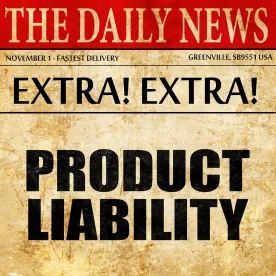On November 23, 2022, a federal court in Minnesota highlighted the importance of strategically approaching product liability claims, both in terms of their underlying defense and their insurability. In Federal Insurance Company v. 3M Company, No. 21-2093 (JRT/DTS), 2022 WL 17176889 (D. Minn. Nov. 23, 2022), the court rejected the insurer’s attempt to treat each underlying lawsuit as a separate occurrence, thereby maximizing per-occurrence deductibles, and instead found that the manufacture of the allegedly defective medical devices was the sole occurrence responsible for each of the lawsuits. 3M, therefore, was only required to pay a single deductible.
Product liability claims can present serious exposure if presented to a jury. One recent report estimated that the average product-liability personal injury jury award now exceeds $7 million for a single plaintiff. Multiplying that by hundreds, or even thousands of plaintiffs, can quickly add up. Even meritless claims that are dismissed long before trial can still be very costly to defend. Thus, it is critical for companies facing product liability exposures to maintain adequate insurance to mitigate those risks, and assess any claims concerning allegedly defective products strategically to ensure that available insurance coverage is maximized to the greatest possible extent.
Case Background
3M’s subsidiary, Arizant Healthcare, manufactures and sells the Bair Hugger Patient Warming System, a medical device designed to maintain a patient’s body temperature during surgery. Claimants filed thousands of product-liability lawsuits against 3M, alleging injuries caused by the Bair Hugger system between 2003 and 2010. The cases were transferred into a multi-district litigation: In re: Bair Hugger Forced Air Warming Devices Product Liability Litigation, MDL 15-2666 (D. Minn.).
Arizant (an independent company prior to 2010) had purchased general commercial liability insurance from Federal Insurance from 2003 to 2010. 3M (as Arizant’s successor) tendered the MDL to Federal for coverage under the policies, but Federal refused to pay defense costs. Federal then brought suit seeking a declaration that it was not required to pay. The primary issue in the case was how many occurrences—and thus, how many deductibles—there were. 3M contended that it needed to only pay a single deductible per policy year, but Federal argued that the company had to pay a separate deductible for each lawsuit, which could result in thousands of deductibles.
The case involved two different policy forms, and each had their own deductible clauses. First was the 2003–2007 policies, which applied deductibles on a “per occurrence” basis. The policies stated: “Per Occurrence basis – the deducible amount applies to all damages, defense costs, and other Supplementary Payments because of: all bodily injury or property damage as the result of any one occurrence, regardless of the number of persons or organizations who sustain damages because of that occurrence.” 2022 WL 17176889, at *2. “Occurrence” was defined as “an accident, including continuous or repeated exposure to substantially the same general harmful conditions.” Id.
In the second group, the 2008–2010 policies applied deductibles on an “each event” basis. The policies provided:
If the applicable Deductible is indicated to apply on the basis of:
-
Each Claim, then the amount of the Deductible applies separately to the sum of amounts described in the provision titled Deductible Obligations, in connection with loss allocable to each separate person and organization that arises out of each separate “event.”
-
Each “Event,” then the amount of the Deductible applies separately to the sum of amounts described in the provision titled Deductible Obligations, in connection with loss that arises out of each separate “event.”
The 2008–2010 policies used the same definition of “occurrence” as the earlier policies. They also defined “event” as “an occurrence, offense, wrongful act or other cause of loss as described under the applicable Coverage.” Id. at *3.
The Court Rules In 3M’s Favor: Single Deductible
The court found that only a single deductible was required under both policy forms. In doing so, the court analyzed Minnesota law addressing the number of occurrence issues under various fact scenarios and policy wordings. The court concluded that, under similar facts, Minnesota applies the “cause test” rather than the “effect test,” thereby looking to the cause of the alleged injuries rather than the individual injuries for purposes of determining the occurrence(s). 3M, 2022 WL 17176889, at *5–6 (discussing H.B. Fuller Co. v. United States Fire Ins. Co., No. 09-2827, 2012 WL 12894484 (D. Minn. Mar. 2, 2012), and N. States Power Co. v. Fid. & Cas. Co. of N.Y., 523 N.W.2d 657, 664 (Minn. 1994)). Here, the underlying claims were “based not on whether some Bair Huggers were defective but rather that all Bair Huggers were defective in their design and manufacture.” 3M, 2022 WL 17176889, at *8. The alleged “occurrence” or “event,” the court concluded, therefore, was not each individual exposure, but rather 3M’s original design and manufacture of the devices, which is a single occurrence. Id. The court noted, however, that the “cause test” is not necessarily applicable to every claim scenario, thereby underscoring the importance of fully understanding the causation mechanism that gives rise the alleged injuries at issue in each claim for coverage.
Takeaways
The 3M decision highlights the critical importance of carefully analyzing all potentially applicable coverage provisions and their associated definitions, along with the alleged injury-causing process to fully appreciate the impact that a number of occurrences determination can have on the availability of insurance coverage. Here, the insurer determined that, notwithstanding settled Minnesota law that looked to the “cause” as the basis for determining the occurrence, it could benefit substantially by spreading 3M’s exposure across each alleged resulting injury, thereby minimizing, or altogether avoiding, coverage. Policyholders, therefore, should engage knowledgeable coverage counsel early in claims where the number of occurrences may be at issue to ensure that a proper analysis is undertaken and that a prompt challenge is made to any improper attempt by the insurer to use the number of occurrences as a tool to reduce coverage.





 />i
/>i

